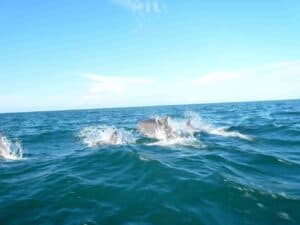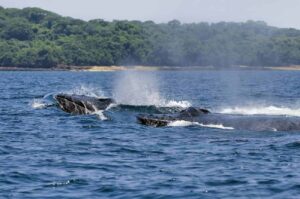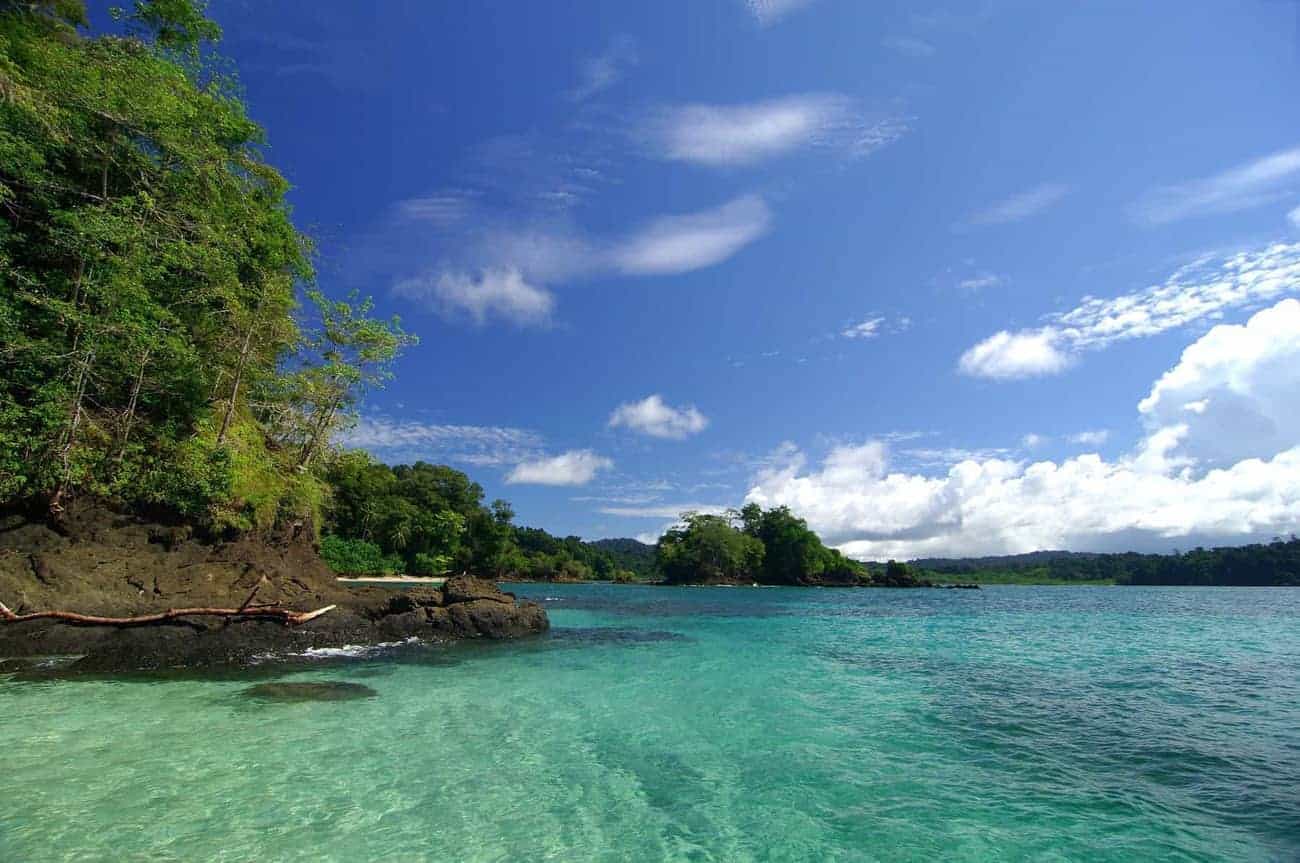The connection and fascination that has always existed between humans and dolphins are undeniable, the Greeks considered them to be sacred animals, and sailors have thousands of stories about them. True stories of dolphins being part of armies, sometimes saving the people’s lives and other marine animals in dangerous situations. Now we tried to protect them.
What do you know about Dolphins? This is a small list of things that you might like to know about them.
The Dolphin’s Origin and their Legends
It seems as if they are always smiling, but have they had that smile forever? Their gracefulness and athleticism amaze us as well. Were they always this talented?
- The long evolutionary history of whales and dolphins, spanning the last 50 million years, records the transition from a four-legged terrestrial animal to the sea made by this group of marine mammals. The first dolphins lived in the rivers (freshwater), then were slowly migrate and adapt to the ocean’s salty waters.
- Once they lived on land also looked and behaved something like a small wolf but with five hoof-like toes on each foot instead of claws. Also have remnant finger bones, a forearm, and wrists in their flippers, also few leg bones deep inside their bodies
- The name “dolphin” comes from the Greek words “delphis” and “delphus,” it’s mean “fish with a womb”
- Whales, dolphins, and porpoises are mammals called cetaceans, which is derived from the Greek word “ketos,” meaning “large sea creature”
- As we said, dolphins are mammals related to whales, but the real whales (Mysticeti) don’t have teeth. Are part of the family of toothed cetaceans (“Odontoceti”) that includes orcas and pilot whales.
Shark, dolphin, and the sea turtle as some of the oldest creatures on Earth
- Cetaceans have warm blood, which means that their body can regulate its own temperature, so they stay warm even when the water temperatures around them are cold. A dolphin’s core body temperature is about 36° to 37°C (96.8° to 98.6°F), about the same as that of a human or dogs
- There were known to serve as messengers from the gods. Tara, son of Poseidon, the ocean god, was saved from a sinking ship by a dolphin.
- Other cultures such as Taiwan, India, Pakistan, Cambodia, Amazon, China, and others, have ancestral stories with dolphins, related to love and beautiful women who transformed into these beautiful creatures.
- The desert city of Petra, established as early as 312 BC in Jordan, has images of dolphins carved in the rocks
- In ancient Rome, dolphins were thought to carry souls to the “Islands of the Blest,” and images of dolphins have been found in the hands of Roman mummies, presumably to ensure their safe passage to the afterlife
- Pirate lore also recognizes the dolphin as a symbol of protection
How smart are dolphins?
While intelligence is difficult to quantify in any organism, many studies suggest that dolphins are smarts as humans.
Whales and dolphins’ brains contain specialized brain cells called spindle neurons. These are associated with advanced cognitive abilities such as recognizing, remembering, reasoning, communicating, perceiving, adapting to change, problem-solving, understanding dolphins possess the ability to beneficially alter their surroundings, form complex social groups and create and emotional bonds. So it seems they are deep thinkers!

- They are highly intelligent marine creatures and are believed to have the longest memory in the animal kingdom, but not more than my wife.
- The Dolphins can recognize themselves in the mirror, and they love to admire themselves.
- In Australia, dolphins fit marine sponges over their beaks to protect them from sharp, harmful rocks as they forage for fish. They are a few animals that have been documented using tools.
- They are notoriously talented mimics and quick learners; they demonstrate self-awareness, empathy, innovation, teaching skills, grief, joy, and playfulness.
- Not only do they learn as individuals, as individuals that can pass their knowledge onto others.
How many dolphins are in the world, and where we can find them?
Given their migratory behavior, it is difficult to count the total population of dolphins on the planet. Population estimates range from several million but the most important is there are some dolphin species that are endangered, yes some of them are almost extinct.
- There are at least five species of dolphins that are endangered or critically endangered, like the Atlantic Humpbacked Dolphin, Ganges River Dolphin, Hector’s Dolphin (The smallest dolphin in the world), Indus River Dolphin, and Irrawaddy Dolphin.
- We can found them worldwide, mostly in shallow tropical waters of the inshore marine areas like Coiba National Park and along with The Coast of Panama. Some of them live in areas where rivers and oceans meet, no matter if freshwater or saltwater like the Gulf of Montijo’s wetlands.
- Coastal populations of common bottlenose dolphins are more territorial and utilize a larger number of coastal habitats – from bays and estuaries to seagrass beds, beaches, and other ecosystems.
- While they’re most commonly associated with oceans, dolphins—and porpoises—can actually be found in several major rivers on two continents. But if that population is on the decline, then it’s considered a red flag for the ecosystem as a whole
About 40 species of dolphins swimming in the world’s waters
- The number keeps changing as science learns more about these marine mammals. Definitively, the best known of all the species is the bottlenose dolphin (because of Flipper 80’s tv series)
- Names and nicknames can certainly be confusing; there are eight dolphin names that feature the word ‘whale’, including long and short-finned pilot whales, false killer whales, and melon-headed whales. Two species have whale and dolphin in their name; the northern right whale dolphin and the southern right whale dolphin – no wonder both the public and scientists get confused!
- Killer whales (Orcas) are actually dolphins and the largest member of the oceanic dolphin family
- Every year, a dolphin’s teeth grow a new layer, similar to the rings inside a tree trunk. Scientists can tell how old a dolphin is from the layers on its teeth
How do dolphins mating and reproduce?
- Dolphin reproduction often involves shows including posturing and vocalizations to attract a mate, they have more than one mate at a time.
- Yes, dolphins are not monogamous and usually mate with several other dolphins. A male may mate several times in an hour, often with the same female but not always, up to 50 copulations a day
- They have sex all year round. Unlike most wild animals, dolphins spend a lot of time enjoying sex and foreplay, which is not determined by the urge to procreate or being “in season”
- The male-female courtship ritual plays a large part in mating. Males make elaborate swimming patterns and calls and sometimes dolphins will court or play for days, swimming together and petting each other with their fins. The actual mating is brief and may mate at any time of the year, although mating occurs more frequently after calving season
- When interested in mating, dolphins engage in a playful activity such as chasing each other, head-butting and scratching each other with their teeth, as well as lying on one side like a floating log
- They usually become sexually active at a young age, even before reaching sexual maturity. Though the age varies by their geographic location, females tend to reach sexual maturity at age 5 to 11, and males at age 7 to 14
- Like almost all mammals, give birth to live young carry their babies from nine to 17 months before giving birth to a calf. The babies called Calves and nurses from 11 months up to two years and stay with the mothers anywhere from three to six years
The Dolphins are the only animals that give birth with the baby coming out tail first
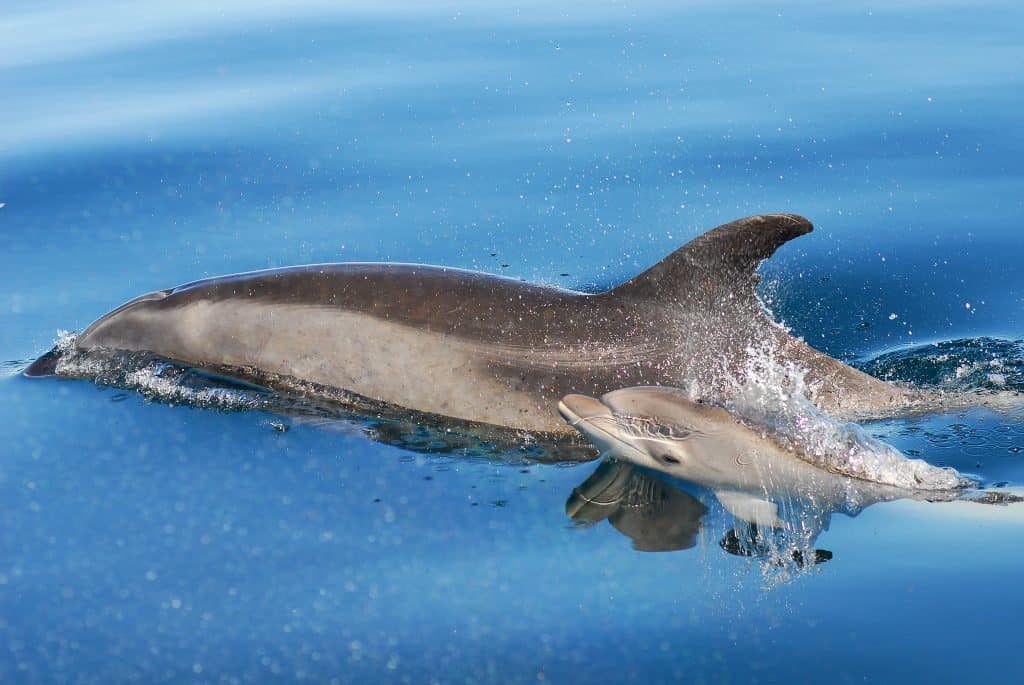
- The calf would drown if it was the other way and must immediately take her baby to the surface to breathe
- Mature females typically give birth every 3 to 5 years until their death, they may give birth as many as 8 times during their lifetime
- The size of a newborn calf is between 90 to 120 cm and weighs about 15 kg. Grows very quickly on the high-fat mother’s milk, in some species doubling its weight within 2 weeks
- The baby dolphin must learn to hold its breath while nursing
- Because dolphins are connected to their mothers by an umbilical cord inside a womb, dolphins have belly buttons
- Mothers are surprisingly maternal and everybody in the group, called pods, takes care of the small ones. A female dolphin can assist in the birth of another’s baby dolphin, and if it is a difficult birth, the “midwife” might help pull out the baby. Other dolphins, swim around the mother during birth to protect her
Dolphin Social Behavior
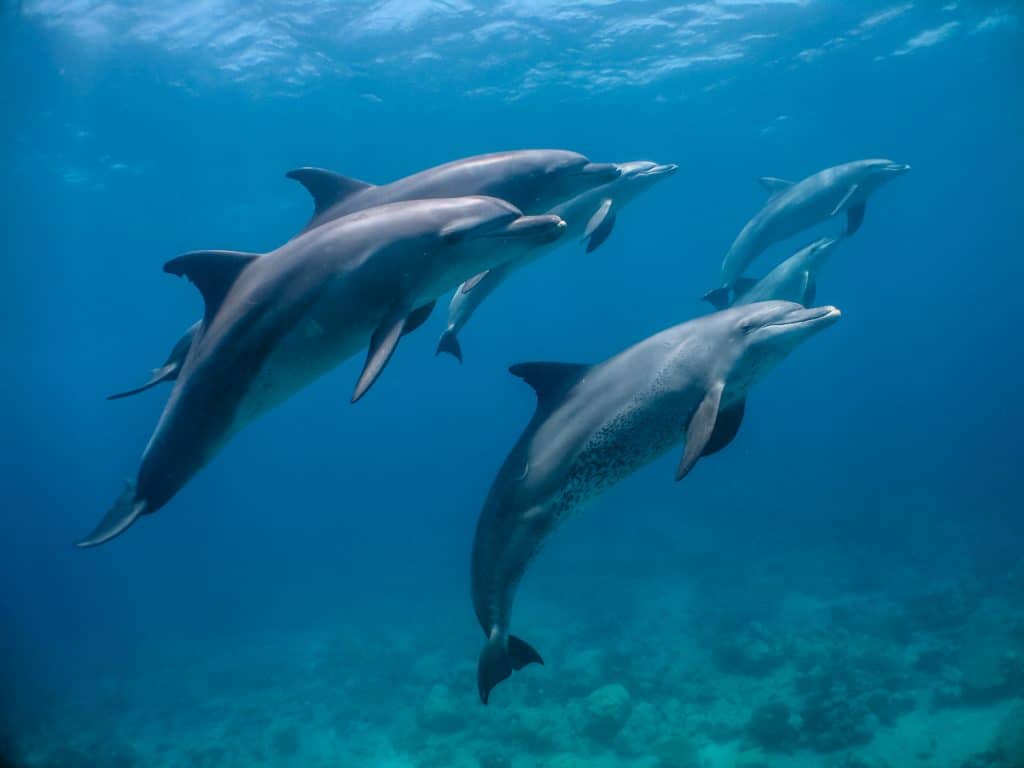
- They are very social, living in family groups that swim and cooperate with each other to hunt, get food, in raising offspring, and even play together. They can be grouped into small pods (in schools) of 12 members or large pods (superpods) of dolphins can have several hundred
- Pod life plays a very important role in protecting dolphins from predators such as sharks
- Groups often have a hierarchy of power with a few individuals considered dominant, like a wolf pack
- They can create social bonds and make friends, yes make friends, like regulars’ person, dolphins seem to prefer the company of certain peers more than others. They are often seen playing and teasing other animals living underwater
- The Dolphins will race towards boats to surf in the bow wave or play in the wake performing amazing acrobatics. Why? Well, wouldn’t you if you could? Some dolphins seek out big waves breaking close to shore and ride the waves alongside surfers, other dolphins prefer to play with plants or shells or other make-shift toys
- Like other families, they help the sick or injured members, are often seen tending to the sick, the old, and the injured in their group
How do Dolphins Communicate?
Scientists agree that they communicate with each other in sophisticated and at times, novel and interactive ways.
- There are social creatures that communicate with each other underwater by making squeaks, squawks, whistles, clicks, moans, barks, groans, and yelps. We can say they have their own language. We can say they have their own language and a vocabulary of danger sounds, food sounds, and seeking sounds, and sometimes put these sounds together in a reasonably complex fashion.
- They don’t have vocal cords, they produce sounds from inside their heads through their blowhole. Also have an excellent sense of hearing, with a well-developed hatred.
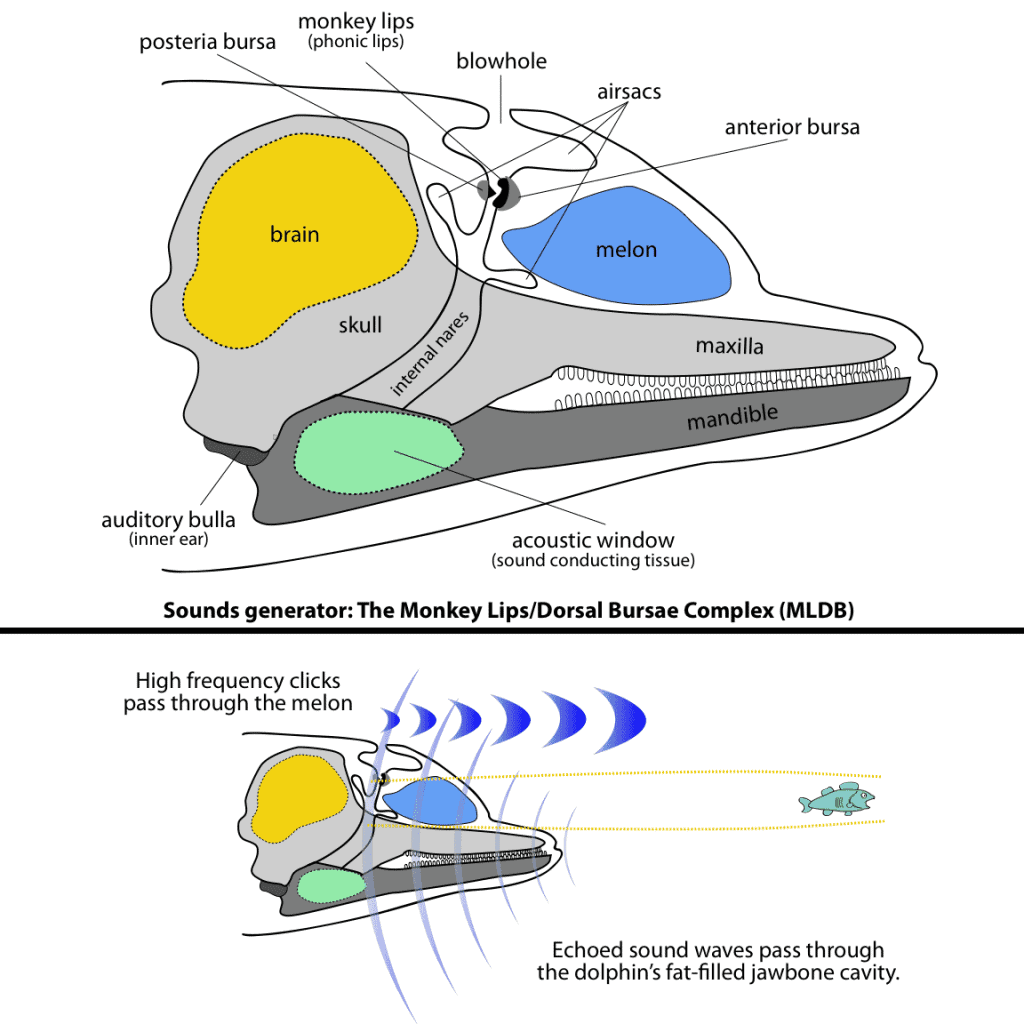
- Perhaps the most amazing thing is they exhibit a great tendency to take turns when vocalizing, better than “some people”.
- Every dolphin has its own unique name (whistle), which the mothers give then when born, dolphins use these signature whistles for life to call out to one another. Even some mothers also produce a burst-pulse to reprimand their offspring for bad behavior.
- In experiments with dolphins, scientists succeeded to assign new sounds (names) to different objects and dolphins were able to add them to their vocabulary.
Does Dolphin have superpowers?
Many know the Marvel Comics or DC Comic superheroes, well they share some superpowers that dolphins have. As well as any superhero, they love to help others.
- The Dolphins can “see the sounds” with sonar, this superpower is called echolocation. Sound travels much better in water than light does and so it makes more sense for dolphins to sense their surroundings with sound. The sonar is the best within nature and superior to bats’ sonar and human-made sonar.
- They can check out each other’s pregnancies and eavesdrop on the echolocating clicks of other dolphins to figure out what they’re looking at
- These amazing animals also act as bio-indicator. Observing dolphins helps us to determine an environment’s ecological health, even more reason to love and cherish these magnificent animals
- Did you know that dolphins don’t sweat and they don’t have a sense of smell? even don’t have a good sense of taste but can distinguish between sweet, sour, bitter, and salty tastes
The dolphins can move each eye independently

- They can move each eye up, down, forward, and backward, giving them nearly 360 degrees of vision
- Like cows, they have 2 stomachs, one is for storage food and the second is for digestion
- They are “equipped” with highly effective healing processes, which means that they don’t hemorrhage to death easily
- Are known as great divers. Being creatures of the sea, they can dive up to 1,000 feet (about 300 meters) underwater and jump as high as 20 feet (about 6 m) out of the water!
- The dolphins are among the world’s most efficient swimmers. Sometimes “porpoise” at the surface; they swim fast enough to break free of the water, flying up and out and then back under in one continuous movement, which they generally repeat. Porpoising uses less energy than swimming fast at the surface.
How do dolphins feed?
- They are carnivores, mostly eating fish, crustaceans, and squids, which they track using echolocation, a built-in sonar that bounces sound waves off prey and reveals information like its location, size, shape, movement, and textures.
- Often co-operatively hunt together by surrounding a school of fish, forming a circle or a U shape and herding the fish, trapping them and taking turns swimming through the school and catching fish
- Also, use a hunting technique called “fish whacking”, they use their tail to hit the fish and so stun them making them easier to catch
- Another fishing technique is “Bubble Nets” by releasing a cloud of bubbles from their blowholes or creating bubbles by driving their flukes through the surface of the water repeatedly which causes the fish to school within the wall of bubbles
- They use their teeth only to hold the fish and then swallow them whole, without chewing. They use the muscles at the back of their tongue and throat to squeeze the saltwater out and eat the fish.
- The bottlenose dolphin can eat between 15 to 30 pounds of food every day, the Orcas can consume up to 500 pounds of fish per day
- They don’t drink water because they get it from the food they eat. They have the same reaction to drinking saltwater as humans do: it would dry them out until they died of dehydration
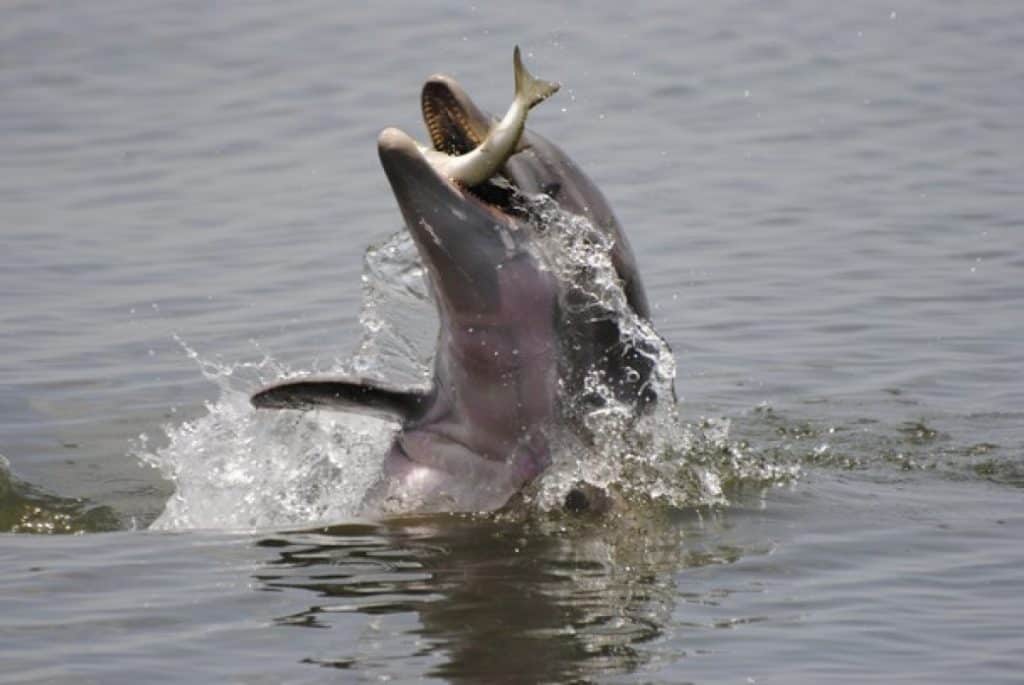
Dolphins breathe underwater like fish?
Despite being marine animals, they don’t have fish gills. They must come to the surface to get air just like you do; they spend most of their lives holding their breath underwater. The dolphin is able to squeeze every bit of oxygen from its lungs in this way to stay down.
- When a dolphin surfaces for air, he exhales first and then inhales fresh air; it only takes a fraction of a second for the dolphin to do this.
- Typically, resurface to breathe three to twelve times per minute, but they can hold their breath for from 7 to 30 minutes
- His breathing is very efficient, exchanges 80% of the air in his lungs with each breath, while humans only exchange 17% of the air in their lungs with each breath
The dolphins could not breathe through their mouths in the same way as people can, only through their blowholes
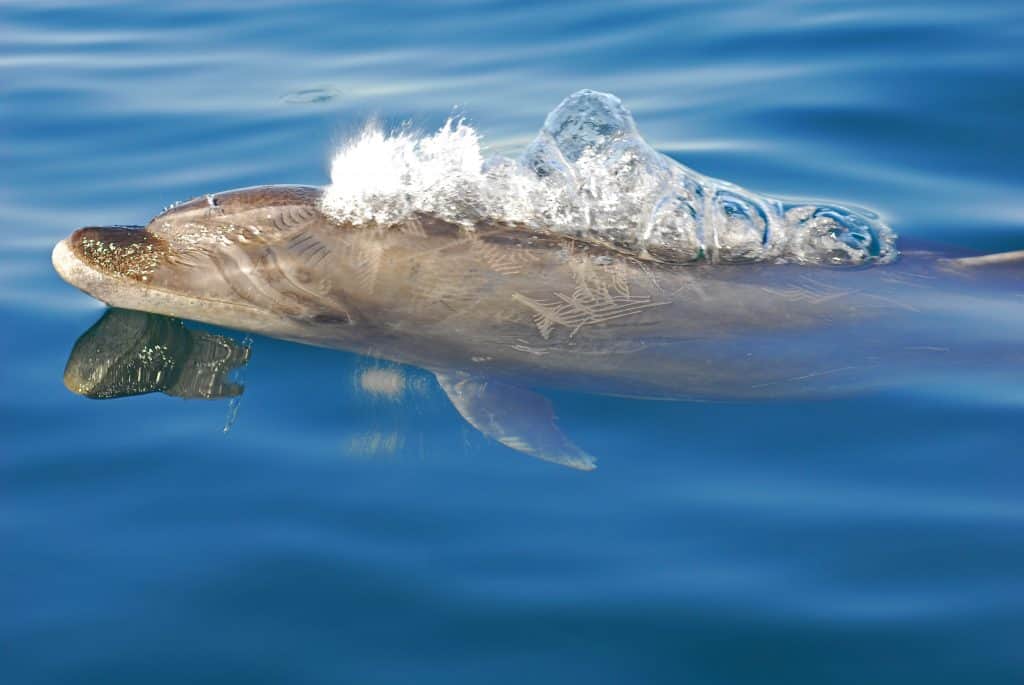
- The Dolphins eat through their mouths and breathe through their blowholes located on top of the head like a evolved from the nose. While swimming, it has the ability to close its blowhole so that water doesn’t leak in, this prevents the dolphin from sucking up water into the lungs when hunting, reducing the risk of drowning
- They would drown, just if a single tablespoon of water entered their lungs
- The cetaceans can’t breathe automatically as humans do. Whales and dolphins must keep part of the brain alert to trigger each breath voluntarily, for this reason, they will die if given a general anesthetic
Now tell me, How the dolphin do sleep without drowning?
- By resting one hemisphere of their brain at a time, dolphins can continue swimming, breathing, and watching for predators 24/7 keeping one eye open at the time
- Dolphins spent about a third of each day sleeping (state similar to napping called cat-napping) about 8 hours, mostly at night. When they sleep they are able to float, and small movements of their tail flukes propel them to the surface so they can take a breath every now and then as they sleep
- The visible spout of water that often rises from a dolphin’s blowhole is not coming from the lungs, which (like ours) don’t tolerate water. Water that is on top of the blowhole when the powerful exhale begins is forced up with the exhaled respiratory gases. Especially in cool air, a mist may form; it is water vapor condensing as the respiratory gases expand in the open air
- If you are close by, it is easy to hear a dolphin’s ‘blow’ at the surface; in fact, you will often hear a dolphin before you see him! The blow is the sound you hear, and the spray of water you see
- Like other marine mammals, they have a slower heart rate while diving. During a dive, blood is shunted away from tissues tolerant of low oxygen levels toward the heart and brain, which require a constant supply of oxygen
- They have high amounts of hemoglobin and myoglobin to store oxygen in their blood and body tissues even shut down some organs when they dive to help them survive in the deep
Dolphin Anatomy and Appearance
Dolphins have evolved to have a very streamlined fusiform and hydrodynamic body, perfectly adapted to life in the water for fast swimming, sudden dynamic movements, and changes in direction.
- The dolphin’s tail has two parts called flukes, they use them to propel their body through the water, provides massive propulsion and acute directional control. They use their pectoral flippers to swim in a given direction. Their prominent fin also aids mobility, providing stability at speed and through hairpin turns
- Then males tend to be longer and heavier than females. The close presence of a calf usually indicates the dolphin is a female
- They vary in size from 4 feet (1.2 meters) and 90 pounds (40 kilograms) for Maui’s Dolphin, and up to 30 feet (9.5 meters) and 10 tons for Orca or Killer Whale
- The body shape is perfect, they’re very muscular and streamlined, as a living torpedo, they have tendons in the tail that are arranged in a way that gives them a lot of thrusts. Normally travel at about 3 kilometers per hour but can speeds up to 55 kilometers per hour and travel up to 100 kilometers per day
Unlike a fish, which moves its tail from side to side, a dolphin swims by moving its tail up and down
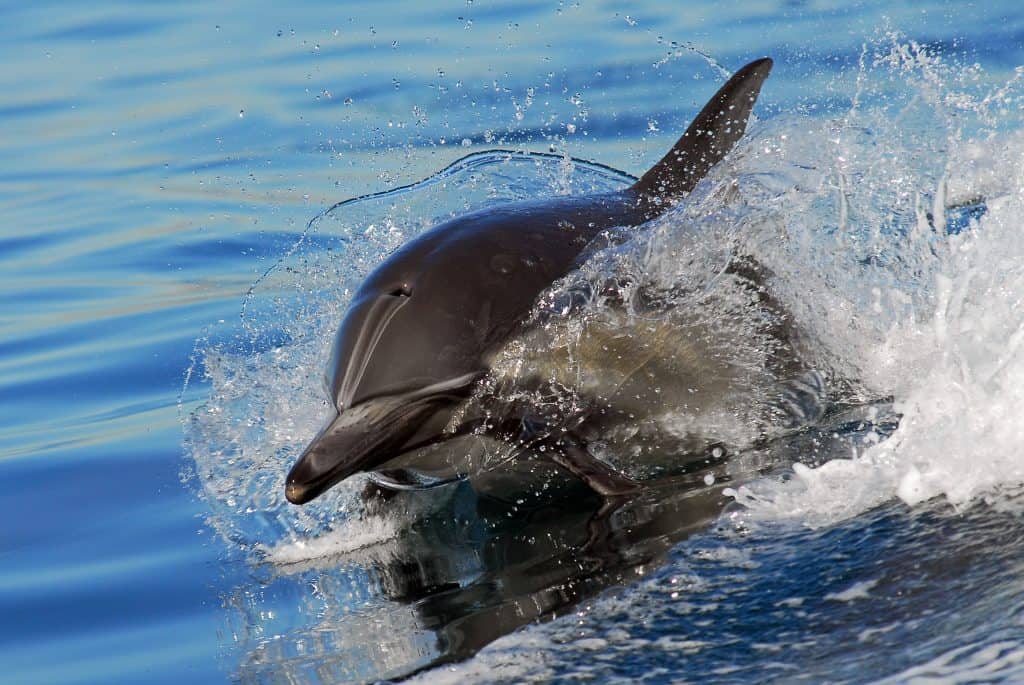
- A dolphin carries more oxygen in its blood than a fish and can swim longer; hence, dolphins are better adapted to the sea than are any fish
- Their skin looks and feels super smooth and sleek to reduces drag as they swim and shed the outer layer of skin 12 times per day, every 2 hours. The shedding of the skin itself reduces drag by disturbing tiny whirlpools of water called vortices, that occur in the flow around the surface of the dolphin and slow it down and plays a vital part in helping them reduce water friction, ‘drags’ and travel faster
- The epidermis, which is the outermost layer of skin, is very thick, it’s actually 10 to 20 times thicker than other mammals. Also have a thick layer of blubber just below their skin that is used for storing fat, temperature insulation, and protection
- Did you know that dolphins start life with body hair? Newborn calves have hairs on their rostrum (their beak) that fall out soon after birth. This is believed to be an evolutionary remnant from when they lived on the land
- Most dolphin species have a long lifespan. It’s estimated that some may have lived for more than 80 years
- The narwhal dolphin has a large ivory tusk (like a unicorn), which is often poached. The only remaining populations are in the Greenland Sea and the Baffin Bay
Dolphin Threats and Challenges
The dolphins are near the top of the marine food chain, are top ocean predators with few predators of their own. Their level of socialization gives them a significant advantage by staying in groups and intimidating their opponent.
They have few natural enemies like sharks and killer whales who occasionally prey upon dolphins, but it is not a common behavior, humans represent a major threat.

- There are several species facing an uncertain future, especially the populations of several river dolphins, due to their proximity to human settlements
- A combination of man-made factors including damming, increased boat traffic, naval sonar use, shoreline development, killed incidentally by long-lines and on hook-and-line and other fishing gear used in fisheries by bycatch, plastic, noise pollution, offshore petroleum derivatives, pesticides, tourism bad practices even climate change, are all dolphins’ threatening
- Due to contamination, some of these toxins are known to interfere with the reproductive ability and weaken the immune system
- Many dolphin deaths have been attributed to swallowing man-made objects including balls, nets, and pieces of plastic. Are also common injuries or deaths due to collisions with boats, especially their propellers
- Side effects include increased stress, damaged hearing, and decompression sickness caused by surfacing too quickly to escape the noise
- Here in Panama, in Dolphin Bay in Bocas del Toro, dolphins have shown significant changes in their feeding and communication habits, due to high marine traffic, bad tourism practices, and underwater noise
Humans are the most dangerous dolphins’ predators.
- Although we don’t live in the sea, we kill more dolphins than any other animal in the ocean. Over 20,000 of the creatures are caught each year
- Dolphins’ sonar seems not to detect the fine threads of fishing nets, and millions of dolphins have drowned as a result of becoming entangled
- They cannot swim backward, which makes it difficult for them to escape fishing nets. If they can’t get to the surface, they can drown in a matter of minutes. More than 20,000 dolphins are estimated to die each year from bycatch
- As a defensive measure, dolphins can kill sharks with their noses. They may even circle around a shark to coordinate an attack
- Not everything is bad, there are organizations like Marviva, Albatros Foundation, Panacetacea, Smithsonian Tropical Research Institute, and the marine biologist, who day by day fight for the conservation of these beautiful creatures.
When you are on a dolphin-watching tour, feel free to take as many pictures as you can, but also be sure to take a minute to appreciate the moment you’re in, complete peace as nature fully surrounds you.
These animals are amazing and intelligent, and they keep surprising us with their “always very happy” behaviors (it seems that they are smiling) and no matter how often we meet them, it’s a memorable experience.


